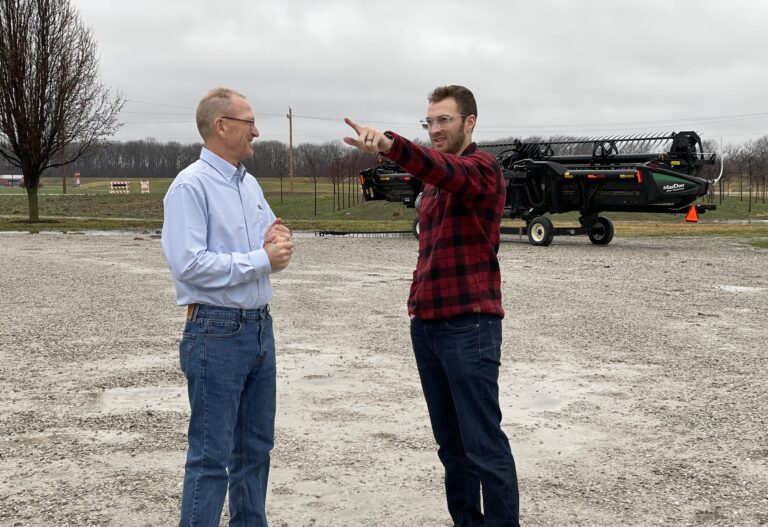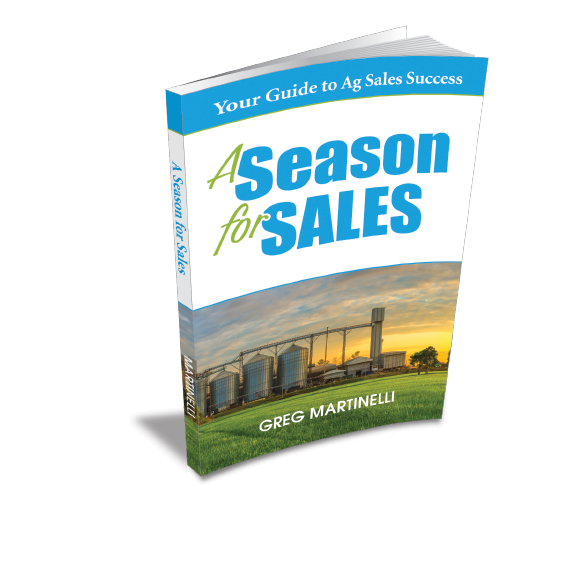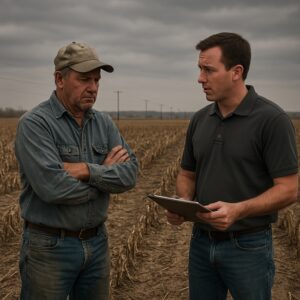What to do when the market kicks you in the teeth!
Every day in the agribusiness world, it happens. Somewhere out there, good, hard-working salespeople are hustling, having success, doing all the right steps to grow their territory, and then it happens. A “bad” thing happens to them. Sometimes their fault. Sometimes with plenty of warning. But often with no red flags and to no fault of their own, something bad happens to them in their territory.
4 bad things that happen: Let’s go from least impact to most impact to a salesperson.
- A Complaint: Hopefully, as a good salesperson, you are planning out your schedule in advance. This means as the day begins, you are on your way to an appointment. Then, the complaint call comes in as you near the end of a 30, 60, or 90-minute drive to your appointment. Your customer or your local office is calling to tell you about a customer complaint: bad product, wrong product, no product, pricing errors, etc. If it’s a dealer, it might be a problem with one of their customers using your products. Whatever it is, you now have to deal with the complaint. Impact: This might ruin a couple of hours, the day, or the whole week, depending on the severity and the fix.
- A large account quits you: This is a tough one as they are significant to your overall territory results. Impact: If the 80:20 rule is in effect, the loss of this one account can impact your entire year and beyond, depending on how prepared you are.
- Your primary market segment takes a downturn: This can range from a temporary problem in your market to something more long-term.
- Your primary market segment shifts: Ok, the downturn is no longer a moment in time. It looks like there is a new reality in your market. Your primary market segment or customer base stopped doing business or changed permanently. Impact: This is a career changer for many up to and including who you work for. Again, much will depend on how prepared you are and how you react.
3 ways to turn them around
- Turning the complaint around: The first thing that needs to be done in a complaint situation is to determine the risk and stop the bleeding. Human safety, dying crops, or dying animals come to the top of the list of those areas that are high risk to the customer and to your company. That’s a “Do a U-turn and get all over it immediately” situation. From there, the risk level drops and you have to make the decision on how you want to handle it. Next: Stop the bleeding, which seems obvious. However, you will be amazed at how many customers will have a complaint about the quality of your product, tell you all about how they think it’s causing damage, but not stop using it.
The first question to ask your customer is, “What have you done with the product in question?” and “How are you getting by if not using my product?” This last question establishes your response time. If they have other products and can get by for several days, then you have time to deal with it. If it has shut down their production line or farming operations, and they are waiting for your emergency shipment or help, then you better step up your response.
Turning this around is 100% in the hands of the local business unit to jump on it and fix it. This is your time to shine and show your customer what you do for them during a crisis. Don’t miss this opportunity by disappearing and hoping it will blow over or someone in the office will take care of it.
Other considerations for a complaint:
-
- The customer’s history of complaints. Is this the first or are they a chronic “Sky is falling” type? Do they exaggerate in other areas or are they straightforward in how they communicate?
- Their engagement level with your company: In other words, did they have a problem with you in another area and this is a retaliation or exaggeration?
- Are you experienced in this product with this type of customer and this type of complaint? If you have no technical background on your products or the problem, you will need to step up your support for the problem. Bring someone in to help.
- Lastly, another consideration is how fast the discussion on compensation comes up. If it’s in the very beginning, I’m now on high alert for added problems the customer might be piling onto the discussion.
- Turning the large account loss around: This one might take a little longer to deal with. The first thing to consider: Is it salvageable? Can you go in and earn their business back? Most likely, this is not a surprise event. It’s the inevitable result of too many withdrawals from the relationship: complaints, pricing issues, product performance, etc. When this happens and a large account picks a new vendor over you, it can feel extremely defeating. You will go through a lot of self-doubt. On top of that, this will make news in your company and your industry. Meaning, it’s not just a private issue for you and your manager. Peers in the office, production, and distribution are going to want to know what is happening. Remember, this is part of their livelihood as well. Maybe even your other large customers will want to know what happened. This all adds to the stress of losing a large account.
First things first: Earn the business back. Speed is your friend in this situation. The faster you act, the better it will appear to your customer. If you had a chance to fix the relationship during the problems, and you didn’t, then you just learned a costly lesson.
Get your plans in order for how you might fix the problems. However, when you get that next meeting after they fired you as their vendor, it’s not just about the problems.
That next meeting is to convince them you are going to be the vendor that doesn’t do business the way you just did. That buyer thinks the only way they got you to respond was to switch vendors. So, they are not going to switch back to you because you lined up better freight rates or fixed your distribution issues. They want to know you will listen to their problems and respond in a timely manner. Obviously, since they switched, they don’t trust you to do that. Ask to remain in some way on board as their supplier and have a chance to perform as you did prior to all the issues.
Other strategies might include:
-
- Bringing in some heavy hitters and the whole team: your manager, production, distribution manager, a technical expert/PhD type.
- Keep in mind that large accounts are typically complicated to sell to. This means that a new vendor might fall flat on their face in the very beginning (darn!). They may have overpromised on what they can deliver to this large account. Stay close and be ready to bail the situation out. Go back 10-30-60-90 days later and check to see how it’s going.
- Surviving and prospering during a temporary downturn that has the potential to become a permanent shift: It happens. Hogs go to 7 cents a pound, milk prices drop out, trade wars go on in wheat in the ’70s, soybeans in 2019, ethanol booms in the 2000s and then drops off. Sometimes it’s temporary. Sometimes the good old days never return. The initial response to a downturn in agriculture and agribusiness is to weather the storm. Because we have so many seasonal aspects and boom-bust events, we tend to treat the downturn as a temporary issue. The other reason is that making a major adjustment in farming or agribusiness takes a lot of resources and time. Ramping up on acres or building a new feed mill is not something done overnight. So, we wait it out.
As Ag Sales Professionals, we can be more resilient than this in how we prepare for these times. I spend a lot of time in my training workshops and coaching sessions on becoming known in your market by your brand. I call it personal brand building. Every top salesperson I know builds their business based on their personal brand. So, my advice is to build your brand intentionally every day. Keep exploring other markets. Dabble with a little R&D (research & development) on your own. You may need one of those marginal market segments one day.
We start out our career trying to find our niche in the market. Maybe we are the best at working with large feed dealers that sell into the hog market. People are eating ham and bacon like crazy and you could never imagine that the hog business is going to change. One day the market decides to go to 7 cents a pound and hog production no longer buys through a dealer network.
Or maybe you are the absolute best person at selecting seed varieties in a four-county area for corn and soybeans. A trade war goes on, a major competitor launches into a program that is too good to pass up, another agronomist moves into the area that is equally as good, or your company decides to launch into a pricing program that kills your seed sales.
Now what? Look upon resiliency and other sources of revenue.
Resiliency means how can you react to this situation. Do it fast enough and you might squelch the lost sales. Did Wal-Mart ever think it would lose billions of dollars to Amazon? Probably not as they were slow to respond. Now, they have Superbowl commercials, online sales, and drive-up shopping.
What about other sources of income? As you evaluate your territory revenue, you really need to think about how diverse your sources are. If all eggs are in one basket, start thinking right now about other markets you could be developing. There are some keys to doing this, which we can deal with another day. However, the sooner you get started the better, as it can take some time to develop. I was lucky enough to have three different markets to pull revenue from. Any one of them were big enough to support a territory: A primary market through a traditional dealer, a direct-to-the-farm for large livestock operations, and a large retail/distributor market. It was unlikely to have a major downturn in all three at the same time. When one was down, I could react, shift focus, make a decision to stay or leave it, and not have a disastrous sales year.
The challenge of this strategy is how well you can wear or switch between multiple hats. One minute you are talking to a dog owner, the next a seasoned buyer for 30 stores, and the next a family farm owner. That might all take place in one hour on several phone calls. This is the great part of being a territory manager. You decide if and how much you want to develop those other markets. If you are good at it, you may have just found your superpower.
Final thought: When you get completely past these bad experiences, you will look back on them kind of like boot camp. It was miserable most of the time to go through, you would never want to go back through it if you didn’t have to, but you feel so much better for having the experience. You will be more knowledgeable and able to handle these in the future. You will be more confident in your personal and business growth, and more resilient.
As always, I hope this helped you on your journey to being more efficient and effective in your selling. Bad things do happen to all of us over a given career as an Ag Sales Professional. If this helped, I ask you to share it with those who might also benefit from it. Sign up for my weekly blog and podcast using the links in this email.
As a final request, take a look at this book written specifically for you – By someone who did and still does all the things in my book





